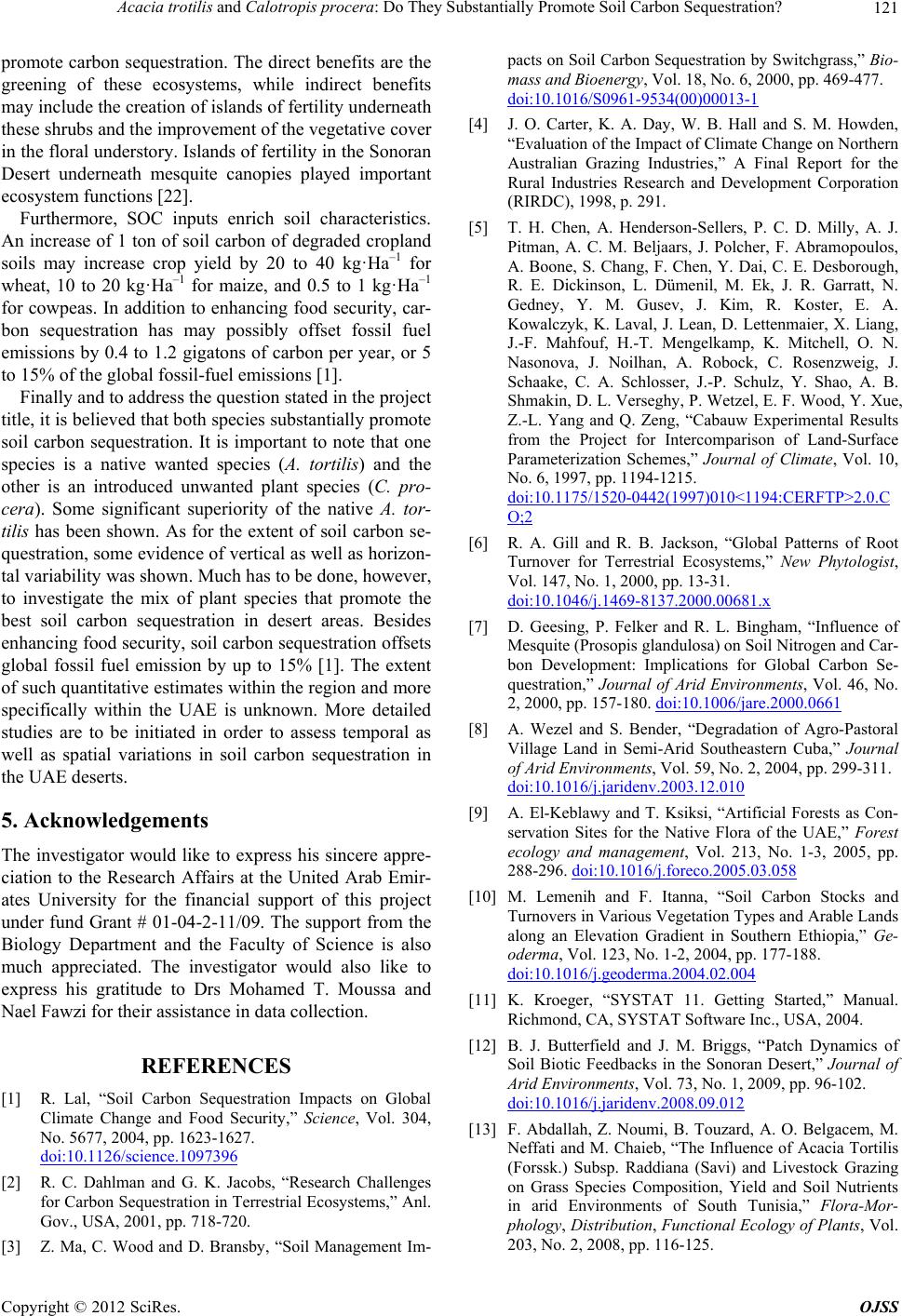
Acacia trotilis and Calotropis procera: Do They Substantially Promote Soil Carbon Sequestration? 121
promote carbon sequestration. The direct benefits are the
greening of these ecosystems, while indirect benefits
may include the creation of islands of fertility underneath
these shrubs and the improvement of the vegetative cover
in the floral understory. Islands of fertility in the Sonoran
Desert underneath mesquite canopies played important
ecosystem functions [22].
Furthermore, SOC inputs enrich soil characteristics.
An increase of 1 ton of soil carbon of degraded cropland
soils may increase crop yield by 20 to 40 kg·Ha–1 for
wheat, 10 to 20 kg·Ha–1 for maize, and 0.5 to 1 kg·Ha–1
for cowpeas. In addition to enhancing food security, car-
bon sequestration has may possibly offset fossil fuel
emissions by 0.4 to 1.2 gigatons of carbon per year, or 5
to 15% of the global fossil-fuel emissions [1].
Finally and to address the question stated in the project
title, it is believed that both species substantially promote
soil carbon sequestration. It is important to note that one
species is a native wanted species (A. tortilis) and the
other is an introduced unwanted plant species (C. pro-
cera). Some significant superiority of the native A. tor-
tilis has been shown. As for the extent of soil carbon se-
questration, some evidence of vertical as well as horizon-
tal variability was shown. Much has to be done, however,
to investigate the mix of plant species that promote the
best soil carbon sequestration in desert areas. Besides
enhancing food security, soil carbon sequestration offsets
global fossil fuel emission by up to 15% [1]. The extent
of such quantitative estimates within the region and more
specifically within the UAE is unknown. More detailed
studies are to be initiated in order to assess temporal as
well as spatial variations in soil carbon sequestration in
the UAE deserts.
5. Acknowledgements
The investigator would like to express his sincere appre-
ciation to the Research Affairs at the United Arab Emir-
ates University for the financial support of this project
under fund Grant # 01-04-2-11/09. The support from the
Biology Department and the Faculty of Science is also
much appreciated. The investigator would also like to
express his gratitude to Drs Mohamed T. Moussa and
Nael Fawzi for their assistance in data collection.
REFERENCES
[1] R. Lal, “Soil Carbon Sequestration Impacts on Global
Climate Change and Food Security,” Science, Vol. 304,
No. 5677, 2004, pp. 1623-1627.
doi:10.1126/science.1097396
[2] R. C. Dahlman and G. K. Jacobs, “Research Challenges
for Carbon Sequestration in Terrestrial Ecosystems,” Anl.
Gov., USA, 2001, pp. 718-720.
[3] Z. Ma, C. Wood and D. Bransby, “Soil Management Im-
pacts on Soil Carbon Sequestration by Switchgrass,” Bio-
mass and Bioenergy, Vol. 18, No. 6, 2000, pp. 469-477.
doi:10.1016/S0961-9534(00)00013-1
[4] J. O. Carter, K. A. Day, W. B. Hall and S. M. Howden,
“Evaluation of the Impact of Climate Change on Northern
Australian Grazing Industries,” A Final Report for the
Rural Industries Research and Development Corporation
(RIRDC), 1998, p. 291.
[5] T. H. Chen, A. Henderson-Sellers, P. C. D. Milly, A. J.
Pitman, A. C. M. Beljaars, J. Polcher, F. Abramopoulos,
A. Boone, S. Chang, F. Chen, Y. Dai, C. E. Desborough,
R. E. Dickinson, L. Dümenil, M. Ek, J. R. Garratt, N.
Gedney, Y. M. Gusev, J. Kim, R. Koster, E. A.
Kowalczyk, K. Laval, J. Lean, D. Lettenmaier, X. Liang,
J.-F. Mahfouf, H.-T. Mengelkamp, K. Mitchell, O. N.
Nasonova, J. Noilhan, A. Robock, C. Rosenzweig, J.
Schaake, C. A. Schlosser, J.-P. Schulz, Y. Shao, A. B.
Shmakin, D. L. Verseghy, P. Wetzel, E. F. Wood, Y. Xue,
Z.-L. Yang and Q. Zeng, “Cabauw Experimental Results
from the Project for Intercomparison of Land-Surface
Parameterization Schemes,” Journal of Climate, Vol. 10,
No. 6, 1997, pp. 1194-1215.
doi:10.1175/1520-0442(1997)010<1194:CERFTP>2.0.C
O;2
[6] R. A. Gill and R. B. Jackson, “Global Patterns of Root
Turnover for Terrestrial Ecosystems,” New Phytologist,
Vol. 147, No. 1, 2000, pp. 13-31.
doi:10.1046/j.1469-8137.2000.00681.x
[7] D. Geesing, P. Felker and R. L. Bingham, “Influence of
Mesquite (Prosopis glandulosa) on Soil Nitrogen and Car-
bon Development: Implications for Global Carbon Se-
questration,” Journal of Arid Environments, Vol. 46, No.
2, 2000, pp. 157-180. doi:10.1006/jare.2000.0661
[8] A. Wezel and S. Bender, “Degradation of Agro-Pastoral
Village Land in Semi-Arid Southeastern Cuba,” Journal
of Arid Environments, Vol. 59, No. 2, 2004, pp. 299-311.
doi:10.1016/j.jaridenv.2003.12.010
[9] A. El-Keblawy and T. Ksiksi, “Artificial Forests as Con-
servation Sites for the Native Flora of the UAE,” Forest
ecology and management, Vol. 213, No. 1-3, 2005, pp.
288-296. doi:10.1016/j.foreco.2005.03.058
[10] M. Lemenih and F. Itanna, “Soil Carbon Stocks and
Turnovers in Various Vegetation Types and Arable Lands
along an Elevation Gradient in Southern Ethiopia,” Ge-
oderma, Vol. 123, No. 1-2, 2004, pp. 177-188.
doi:10.1016/j.geoderma.2004.02.004
[11] K. Kroeger, “SYSTAT 11. Getting Started,” Manual.
Richmond, CA, SYSTAT Software Inc., USA, 2004.
[12] B. J. Butterfield and J. M. Briggs, “Patch Dynamics of
Soil Biotic Feedbacks in the Sonoran Desert,” Journal of
Arid Environments, Vol. 73, No. 1, 2009, pp. 96-102.
doi:10.1016/j.jaridenv.2008.09.012
[13] F. Abdallah, Z. Noumi, B. Touzard, A. O. Belgacem, M.
Neffati and M. Chaieb, “The Influence of Acacia Tortilis
(Forssk.) Subsp. Raddiana (Savi) and Livestock Grazing
on Grass Species Composition, Yield and Soil Nutrients
in arid Environments of South Tunisia,” Flora-Mor-
phology, Distribution, Functional Ecology of Plants, Vol.
203, No. 2, 2008, pp. 116-125.
Copyright © 2012 SciRes. OJSS